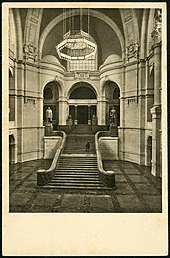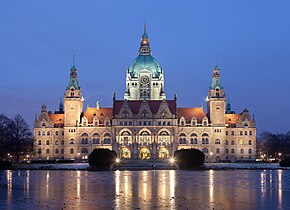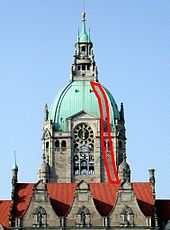New Town Hall (Hanover)
The New Town Hall in Hanover is the town hall of the Lower Saxony state capital and the headquarters of the Hanover city administration under its Lord Mayor . The Wilhelmine, palace -like magnificent building in an eclectic style was built from 1901 to 1913.
The New Town Hall is embedded in the ten hectare Maschpark on the southern edge of the city center, outside of the historic city center of Hanover. The square in front of the north-northeast facing north wing is now called Trammplatz , was created specifically in connection with the town hall building and was named after Heinrich Tramm, the city director at the time . The south side of the building faces the Maschteich .
history
The city's first town hall was the old town hall , the buildings of which were built from 1230. In 1863 the city administration left the old town hall and moved to the nearby Wangenheimpalais .
During the expansion of the city as a result of industrialization, especially since the founding period , the scattered administration of the city of Hanover also grew , so that at the end of the 19th century a new larger town hall became necessary. The driving force behind this was the city director Heinrich Tramm, who had been in office since 1891, and under whom the building was to become “the climax of bourgeois self-expression ”. Initially, the Goseriede north of the old town was discussed as a location . The finally established location on what was then the southern outskirts of the city took into account the simultaneously envisaged expansion of the city to the south (" Südstadt "), combined with a "Rathauspark (Maschpark) extending there as the center of new public buildings ".
The town hall with a height of 97.73 meters, a length of about 129 meters and a width of about 67 meters was built on 6026 beech piles according to plans by the architect Hermann Eggert . The main hall of the town hall was 30 meters long, 21 meters wide and over 30 meters high. The building material, hard sandstone, came from Mehler quarries.
The contract for the construction of the building was the entrepreneur Max Sexton granted, the few years earlier in the 1897 civil ruler - College had been elected and therefore myself in that committee was sitting, which had to decide on procurement.
During the construction work, the architect Eggert was replaced due to differences in the design of the interior of the town hall. The interior work was then mainly carried out by Gustav Halmhuber , who brought in elements of Art Nouveau .
Among the numerous artists involved in the construction, the sculptor Elsbeth Rommel was the only woman who was able to create works that were paid for.
City director Heinrich Tramm commissioned the Swiss painter Ferdinand Hodler to paint the town hall, which was still being built during the German Empire . His monumental painting Einmütigkeit from 1913 has been preserved in what is now the “Hodler Hall”, which was originally used as a joint meeting room for the committees (magistrate and mayor, whose almost mirror-like hall on the west side was destroyed during the war), despite numerous hostilities at the time.
Ferdinand Hodler painting the Hanoverians; Pastel picture by Emil Orlik , 1913
“ Unanimity ”: Dietrich Arnsborg on a raised pedestal made the citizens swear by the teaching of the Reformation in 1533 ;
Painting by Ferdinand Hodler on behalf of Heinrich Tramm, 1913, "Hodler-Saal"“ Authoritarian versus autonomous ?” Duke Ernst the Confessor at the Protestant Supper in 1525;
Relief in the historical frieze on the New Town Hall, Trammplatz ; Sculptor Peter Schumacher
Unlike Hodler's 1913 painting, which emphasizes grassroots democracy , the historical frieze on the facade of the New Town Hall facing Trammplatz , which was created around the same time, emphasizes the rather autocratic , co-determination-hostile understanding of urban autonomy : not the citizens of 1533, but the " As early as 1525, Duke Ernst from Lüneburg, who joined the Reformation for primarily fiscal reasons , [...] had nothing to do with the City of Hanover Citizens' Reformation ”, was immortalized in the relief on the far right of the town hall by the sculptor Peter Schumacher .
In the mosaic hall , the former green or craftsman hall , there is a three-part mosaic picture ( triptych ) of a craftsmen's triumphal procession in the Art Nouveau style in the black marble paneling , subtitled in the middle Handwerk has golden bottom , on the left with the signature of the Rauecker workshop based on a design by Julius Diez .


The bed spring manufacturer August Werner and the councilor Siegmund Seligmann donated the two imperial statues to the city of Hanover : the more than 3 meter high bronze statues of Kaiser Wilhelm I and Wilhelm II were created by the Berlin sculptor and professor Adolf Brütt . They were set up at the side of the large staircase in the central hall and were later melted down for armaments production during World War II .

hand- colored and protective lacquered photo in cabinet format by Carl Thies
After twelve years of construction, the New Town Hall was inaugurated on June 20, 1913 in the presence of Wilhelm II . The building price at the time was ten million marks:
"Ten million marks, your Majesty - and everything paid for in cash."
The building was badly damaged in the air raids on Hanover . In 1946 the state of Lower Saxony was proclaimed in the town hall hall .
On the ground floor of the town hall hall there are four city models of Hanover that show the development of the city center. They show the cityscape in the baroque period (1689), the time before the Second World War (1939), after the war damage (1945) and in the current state.
In preparation for the 750th anniversary of the city's founding (1991) and as a forum for active citizen participation , the then Lord Mayor Herbert Schmalstieg and Chief City Director Hinrich Lehmann-Grube initiated the Association of Friends of Hanover in 1988 , which was then also founded in the New Town Hall.
Entrance hall during the storming of the town hall on 11.11. by carnivalists
Tattoo at the end of the shooting festival behind the New Town Hall (south wing)
Town hall dome with elevator
The height of the town hall dome with its viewing platform is almost 100 meters (97.73 m). Unique in Europe is the dome elevator , which has an arc-shaped (parabolic following the dome) course of travel. It is often incorrectly referred to as an inclined elevator and compared with the ones in the Eiffel Tower , which only drive there diagonally without changing the incline.
The elevator started operating in 1913. The car was guided in steam-bent oak rails. The two carrying ropes lie on three double rollers in the shaft wall while the vehicle is moving downwards. Due to the weather, the elevator could not be used in the winter months. A spiral staircase leads from the elevator exit to the viewing levels. In 2005 over 90,000 people visited the town hall tower. A new elevator was installed in the winter of 2007/2008; the last ride of the old elevator took place on November 4, 2007 with Lord Mayor Stephan Weil and about 1,200 other people that weekend. The new domed elevator went into operation on April 27, 2008.
Since its renovation, it has also been referred to by the city administration and in the media as a bow elevator or bow elevator. At an angle of up to 17 ° it climbs 50 meters in the shaft to the dome gallery, from where the Harz can be seen when visibility is good . The elevator moves horizontally by over 8 meters.
Construction of the tower
The central dome, in which the city models of Hanover are exhibited, is located above the vaulted cellar . On top of this dome is a false ceiling in which the chandelier elevator is installed. Above the ceiling plate there is another dome and two circumferences open on all sides with an inner size of 21 m × 21 m × 30 m in height. A south-facing clock is housed in this second dome. The clock visible from Trammplatz is in the northern roof truss. Only above this dome is the spiral staircase that can be reached by elevator to the viewing levels.
See also
literature
- The royal capital and residence city of Hanover (ed.): Festschrift for the inauguration of the town hall in 1913. Gebrüder Jänecke Hofbuchdruckerei, Hanover 1913.
- Gustav Halmhuber: The interior construction and the plaza of the town hall in Hanover. Lima Verlag, Charlottenburg (Berlin), around 1914.
- Charlotte Kranz-Michaelis: Town halls in the German Empire. 1871 - 1918 (= materials on 19th century art, volume 23). Prestel, Munich 1982, ISBN 3-7913-0384-8 , pp. 395-414.
- Gerd Weiß, Marianne Zehnpfennig: Town Hall. In: Hans-Herbert Möller (Hrsg.): Monument topography Federal Republic of Germany / Architectural monuments in Lower Saxony / City of Hanover. Part 1, (Vol.) 10.1. Friedr. Vieweg & Sohn Verlagsgesellschaft, Braunschweig / Wiesbaden 1983, ISBN 3-528-06203-7 , p. 100; as well as middle. In: Annex directory of architectural monuments according to § 4 NDSchG (except for architectural monuments of the archaeological monument preservation) , status: July 1st, 1985, City of Hanover, Lower Saxony State Administration Office - Institute for Monument Preservation , p. 6f.
- Adelheid von Saldern : An office with a "bad taste"? The housing office on Trammplatz. In: Adelheid von Saldern u. a .: Everyday life between Hindenburg and Haarmann. Another city guide through Hanover in the 20s , publisher: Geschichtswerkstatt Hannover, Hamburg: VSA-Verlag, 1987, ISBN 3-87975-397-0 , pp. 69-76.
- Wolfgang Steinweg: The town hall in Hanover. From the imperial era to the present. Schlueter, Hannover 1988, ISBN 3-87706-287-3 .
- Michael Krische : The New Town Hall Hanover. Origin - architecture - meaning. Published by the state capital Hanover. zu Klampen Verlag, Springe 2006, ISBN 3-934920-99-3 .
- Helmut Knocke , Hugo Thielen : Trammplatz 2. In: Hanover. Art and culture lexicon . Schäfer, Hannover 1994, ISBN 3-88746-313-7 , pp. 206ff.
- Hugo Thielen: Hodler, Ferdinand. In: Dirk Böttcher , Klaus Mlynek, Waldemar R. Röhrbein, Hugo Thielen: Hannoversches Biographisches Lexikon . From the beginning to the present. Schlütersche, Hannover 2002, ISBN 3-87706-706-9 , pp. 170f.
- Helmut Knocke: New Town Hall. In: Klaus Mlynek, Waldemar R. Röhrbein (eds.) U. a .: City Lexicon Hanover . From the beginning to the present. Schlütersche, Hannover 2009, ISBN 978-3-89993-662-9 , p. 466f.
-
Cornelia Regin (Ed.): Splendor and Power. Festschrift for the 100th anniversary of the inauguration of the New Town Hall in Hanover (= Hannoversche Studien. Series of publications by the Hanover City Archives, Volume 14). Verlag Hahnsche Buchhandlung, Hannover 2013, ISBN 978-3-7752-4964-5 , therein a. a .:
- Gerhard Schneider: Ferdinand Hodler and his painting for the New Town Hall in Hanover. Pp. 167-199.
- Carl-Hans Hauptmeyer : Authoritarian versus Autonomous? In: Municipal self-government and town hall - a historical longitudinal section. Pp. 37-52.
Web links
- Information from the city of Hanover on the New Town Hall
- New town hall as a 3D model in SketchUp's 3D warehouse
- New town hall 1913
- Interactive 360 ° panorama photo of the interior of the town hall
- Interactive 360 ° panorama photo of the back of the town hall with Maschpark
- Hannoversche Allgemeine Zeitung of May 4, 2007: Ernst Marow's portrait of Martin Neuffer hangs in the painting gallery New Town Hall Hanover
- Interactive 360 ° tour by Hannover Marketing & Tourismus GmbH of the New Town Hall in Hannover
References and comments
- ↑ a b Helmut Knocke: New Town Hall. In: Stadtlexikon Hannover . P. 466f.
- ↑ a b c d Info flyer - The New Town Hall in Hanover. In: hannover.de , accessed on December 7, 2015 (PDF; 2.7 MB).
- ↑ Waldemar R. Röhrbein : Küster, (2) Max. In: Hannoversches Biographisches Lexikon , p. 216f .; via google books
- ↑ Karin Ehrich: Hanover's women and the new town hall , in Cornelia Regin (ed.): Splendor and power. Festschrift for the 100th anniversary of the inauguration of the New Town Hall in Hanover (= Hanoverian Studies Volume 14). Hahn, Hannover 2013, ISBN 978-3-7752-4964-5 , pp. 381-408; here: p. 402f. and notes according to Werner Heine from the Hanover City Archives , Oswald Rommel registration card .
- ↑ Gerhard Schneider: Ferdinand Hodler and his painting for the New Town Hall in Hanover (see literature)
- ↑ Carl-Hans Hauptmeyer: Authoritarian versus autonomous? (see literature)
- ↑ Helmut Knocke, Hugo Thielen: Trammplatz 2 (see literature)
- ^ Helmut Knocke , Hugo Thielen : Trammplatz 2. In: Hannover Art and Culture Lexicon , p. 206ff.
- ↑ Petra Spona: "The equipment of a town hall is an area in which the public spirit of the citizenry can be active". In: Cornelia Regin (Ed.): Splendor and Power. Festschrift for the 100th anniversary of the inauguration of the New Town Hall in Hanover. Hahnsche Buchhandlung, Hannover 2013, pp. 227–248, here: pp. 229f., 238f.
- ↑ Note: Deviating from this, in the article on August Werner in the Hanoverian Biographical Lexicon and in the City Lexicon Hanover (see literature ), the bed spring manufacturer is named as the sole donor.
- ^ Waldemar R. Röhrbein: Werner, (1) August. In: Stadtlexikon Hannover. P. 672.
- ↑ Freundeskreis Hannover / At the start the club lets it pop. In: Hannoversche Allgemeine Zeitung . December 1, 2008, p. 6f.
- ^ Klaus Mlynek : Freundeskreis Hannover eV In: Stadtlexikon Hannover. P. 191.
Coordinates: 52 ° 22 ′ 2 " N , 9 ° 44 ′ 15" E

















